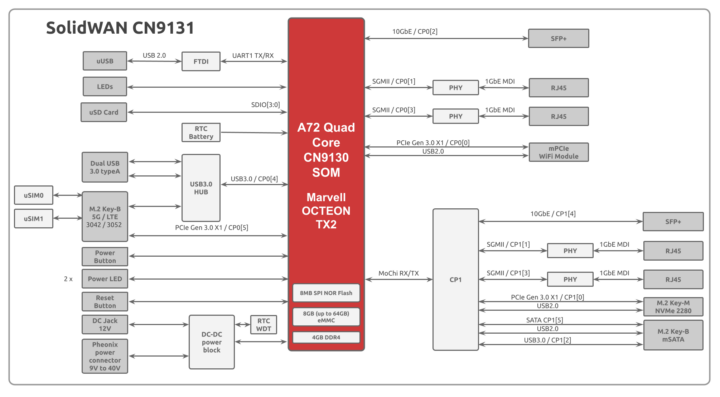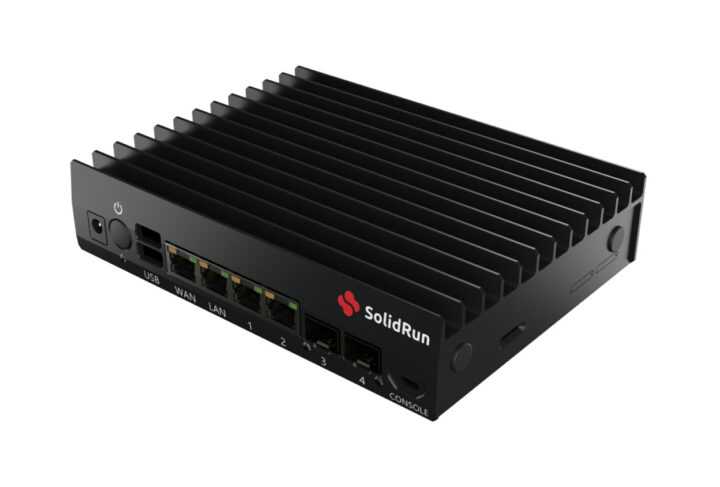SolidRun has just introduced the SolidWAN CN9131 SD-WAN appliance powered by a Marvell OCTEON CN9131 quad-core Cortex-A72 processor and with a compact form factor and features that makes it suitable for small offices.
The Linux-based Software Defined-WAN appliance comes with 4GB to 8GB RAM, 8GB to 64GB eMMC flash storage, plus M.2 SATA and NVMe sockets, and offers four GIgabit Ethernet ports and two 10GbE SFP+ cages for networking connectivity, as well as two USB 3.0 ports.
SolidWAN CN9131 specifications:
- System-on-Module – CN9130 SOM with
- SoC – Marvell OCTEON CN9131 quad-core Arm Cortex A72 clocked at up to 2.2GHz
- System Memory – 4GB – 8GB (4GB default) 64-bit DDR4 @ 2400MT/s
- Storage – 8GB eMMC flash with options up to 64GB, 8MB SPI NOR flash
- Storage
- M.2 SATA and/or NVMe SSD (See Expansion section)
- MicroSD card slot accessible from the outside
- Networking
- 2x 10GbE SFP+ cages
- 4x Gigabit Ethenret RJ45 ports
- Optional WiFi via mini PCIe socket
- Optional 4G LTE via M.2 socket and SIM card slot
- USB – 2x USB 3.0 ports
- Expansion
- mPCIe (WiFi AP mini-pcie module)
- M.2 Key-B with SIM holder
- M.2 Key-M 2280 (NVMe) socket
- M.2 Key-B 2280 (SATA) socket
- Debugging – Micro USB to UART console port
- Misc – RTC + battery
- Power Supply
- 12V/3A DC Jack
- 9V-44V Phoenix DC input
- Dimensions
- PCBA: 225 x 100mm
- Enclosure: 255 x 105 x 35mm (fanless conducting metal)
- Temperature Range – Commercial: 0°C to 40°C; industrial: -20°C to 65°

SolidRun provides support for Debian, Ubuntu, and OpenWrt operating systems. More details about the SoM and software can be found on the documentation website, including some instructions to use the DPDK (Data Plane Development Kit). But note the website feels fairly slow and I had a few 500 HTTP errors when browsing the documentation. Hopefully, it’s just a transient issue.
The SolidWAN CN9131 is the first Marvell-based hardware part of the SolidWAN family, but the company had previously launched the SolidWAN Single LX2162 and SolidWAN Dual LX2160 based on the NXP LayerScape 12-core and 16-core Arm Cortex-A72 processors previously. We don’t have pricing information for the new SolidWAN CN9131, but it should be an entry-level solution compared to the NXP models since it lacks 25GbE and 100GbE interfaces and comes with fewer cores. Additional information may be found on the product page and the press release.
Thanks to TLS for the tip.

Jean-Luc started CNX Software in 2010 as a part-time endeavor, before quitting his job as a software engineering manager, and starting to write daily news, and reviews full time later in 2011.
Support CNX Software! Donate via cryptocurrencies, become a Patron on Patreon, or purchase goods on Amazon or Aliexpress






For me it’s “just” a revamped MacchiatoBin. Not that it’s bad in itself, the mcbin was an excellent machine with great specs. But here the 9131 is nothing more than an armada8040 with a new name to follow the Cavium branding despite being completely different, and a 10% frequency bump. Even the DDR4 is still limited to 2400 MT/s (and the mcbin takes 16GB BTW). I’d have hoped to finally see an Octeon10 there (Neoverse-N1) instead of a somewhat dated A72 by now. I think the device is perfect for those who continue to need to buy mcbins because they’ll… Read more »
CN9131 used 16nm instead of 28nm if I remembered it correctly. It should consumes less power than Armada8040.
I looked for that info for a while in the past already and never found it, making me think they did not even change that. If that’s true I agree that it’s a nice improvement. Still, my guess is that they maintain a foggy area there, with only the TX2 line being etched in 16nm (as they were previously) and the 913x remaining at 28nm like the 8040 before. Since there’s hardly any public info on power draw from Marvell it’s not easy.